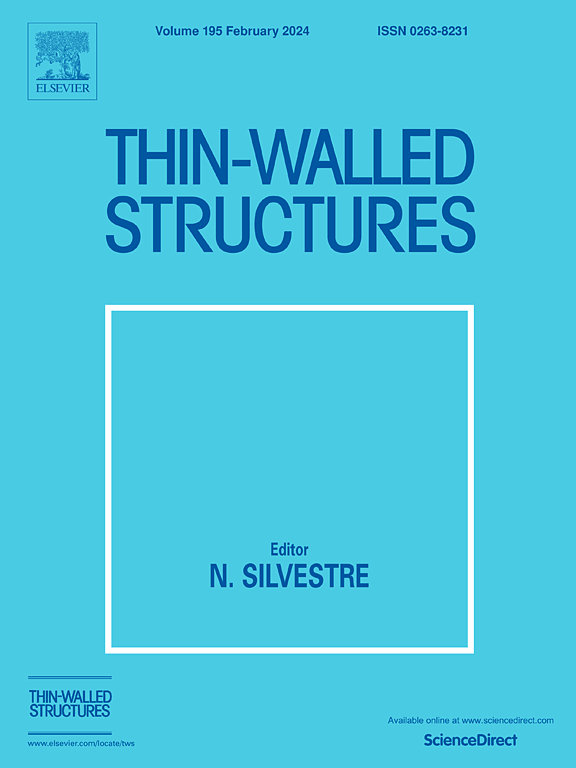不同循环轴向加载方式下冷弯S30408不锈钢方空心截面支撑结构性能试验研究
IF 6.6
1区 工程技术
Q1 ENGINEERING, CIVIL
引用次数: 0
摘要
本文研究了冷弯S30408不锈钢方空心截面(SHS)支撑在不同轴向循环加载历史下的结构性能。对13根SHS支撑进行了循环加载试验,关键参数包括板宽厚比、构件长细比、加载历史等。除60 × 60 × 3 × 1200-DA1试件外,所有试件的宽厚比均满足欧洲规范3 (EC3)规定的1级截面要求,从而保证了塑性变形的充分发展。结果表明,这些参数对试件的结构性能有显著影响,特别是在最大抗压承载力、延性、能量耗散以及局部和整体屈曲行为方面。特别是,加载方案对延性系数、断裂寿命、能量耗散和极限抗压强度有显著影响。现有的几种预测抗屈曲性的设计方法,包括欧洲规范3 (EN 1993-1- 4:16)、ASCE 8-22冷弯不锈钢构件指南、中国不锈钢结构标准(CECS 410-2015)和连续强度法(CSM)的规定,都根据实验结果进行了严格评估。结果表明,与细长支撑相比,目前的设计方法倾向于对短支撑构件的抗压屈曲能力提供保守的估计,这主要是由于忽略了不锈钢的循环硬化效应。本文章由计算机程序翻译,如有差异,请以英文原文为准。
Experimental study of the structural behavior of cold-formed S30408 stainless steel square hollow section braces under various cyclic axial loading protocols
This study investigates the structural performance of cold-formed S30408 stainless steel square hollow section (SHS) braces subjected to different cyclic axial loading histories. A total of thirteen SHS braces were tested under cyclic loading, with key parameters including plate width-to-thickness ratio, member slenderness ratio, and loading history. Except for the 60 × 60 × 3 × 1200-DA1 specimen, all width-to-thickness ratios satisfied the Class 1 section requirements specified in Eurocode 3 (EC3), thereby ensuring the full development of plastic deformation. The results demonstrated that these parameters had a significant influence on the structural performance of the specimens, particularly in terms of maximum compressive load capacity, ductility, energy dissipation, and both local and global buckling behaviors. In particular, the loading protocol exhibited a pronounced effect on ductility coefficients, fracture life, energy dissipation, and ultimate compressive strength. Several existing design approaches for predicting buckling resistance, including the provisions of Eurocode 3 (EN 1993-1-4:2016), the ASCE 8-22 guidelines for cold-formed stainless steel members, the Chinese standard for stainless steel structures (CECS 410-2015), and the Continuous Strength Method (CSM), were critically evaluated against the experimental results. The result revealed that current design methods tend to provide conservative estimates of compressive buckling resistance for short bracing members, as compared with slender braces, primarily due to the omission of cyclic hardening effects of stainless steel.
求助全文
通过发布文献求助,成功后即可免费获取论文全文。
去求助
来源期刊

Thin-Walled Structures
工程技术-工程:土木
CiteScore
9.60
自引率
20.30%
发文量
801
审稿时长
66 days
期刊介绍:
Thin-walled structures comprises an important and growing proportion of engineering construction with areas of application becoming increasingly diverse, ranging from aircraft, bridges, ships and oil rigs to storage vessels, industrial buildings and warehouses.
Many factors, including cost and weight economy, new materials and processes and the growth of powerful methods of analysis have contributed to this growth, and led to the need for a journal which concentrates specifically on structures in which problems arise due to the thinness of the walls. This field includes cold– formed sections, plate and shell structures, reinforced plastics structures and aluminium structures, and is of importance in many branches of engineering.
The primary criterion for consideration of papers in Thin–Walled Structures is that they must be concerned with thin–walled structures or the basic problems inherent in thin–walled structures. Provided this criterion is satisfied no restriction is placed on the type of construction, material or field of application. Papers on theory, experiment, design, etc., are published and it is expected that many papers will contain aspects of all three.
 求助内容:
求助内容: 应助结果提醒方式:
应助结果提醒方式:


